#zone 7b plants
Text
For all you gardeners, farmers, botanists, horticulturalists, and other plant people: The USDA announced a new Plant Hardiness Zone Map yesterday, the first one in over a decade. The map shows the overall climate of the country in relation to plants, and helps determine which plants are most likely to thrive at a location.
Basically, due to climate change, almost every zone boundary has moved slightly northward.
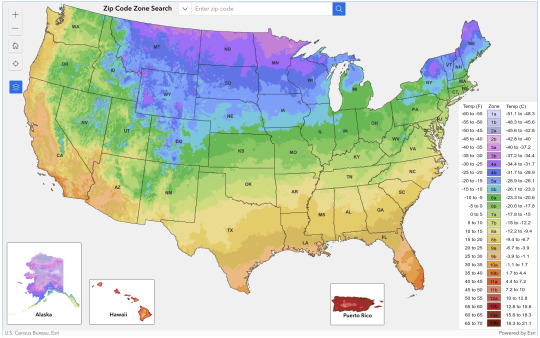
A link to the live interactive map is here, and you can either pan and zoom, or search by zip code.
#my house in Maryland moved from Zone 7a to 7b#plants#botany#gardening#farming#horticulture#landscape design#landscape architecture
4 notes
·
View notes
Text

Ha ha plant grow
#container gardening#garden#tomato plants#heirloom tomatoes#mine#zone 7b btw. tomatoes started from seed
1 note
·
View note
Text
food & agriculture in fallout: extrapolation and speculative worldbuilding
Okay, well. This is going to be an extremely long and data heavy post. Bear with me.
I'm going to go into detail about the crops and available food given to us canonically and textually. I'm going to be drawing some real world parallels between the crops we see in Fallout and what we have here. I'll be pulling relevant data from all the games, but the majority focus on this post is going to be about the east coast and Massachusetts in particular because it gives us the opportunity to participate in the agricultural climate of the wasteland.
Is there a point to this? Not really, but I'm pedantic and I take things too seriously.
my sources will be linked in the text throughout. for those of you who want to read about agricultural and growing zones of the continental united states, please follow me under the cut.
Growing zones and real world agriculture
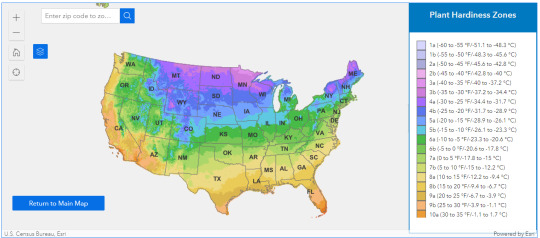
Shown here are the growing zones of the united states, divided into a temperature map of about 19 different regions. It's fairly intuitive to read -- colder temperatures are north and east, while warmer temperatures are south and west. The majority of the Mojave desert sits between 7a to 9a, a temperature range of about 20 degrees. DC and the nearby section of the southeast coast sits between 7a and 8a. The interactive map linked below will tell you where your growing zone sits.
The 2012 USDA Plant Hardiness Zone Map is the standard by which gardeners and growers can determine which plants are most likely to thrive at a location. The map is based on the average annual minimum winter temperature, divided into 10-degree F zones and further divided into 5-degree F half-zones.
For the moment, we are going to focus on Massachusetts.

Using the temperature above, we can see that the growing zone of Massachusetts is 5a (-20f) at it's very coldest, all the way to 7b, (5f) at it's warmest during winter. Most of what we see in fallout 5 sits in the 6a to 6b zone, which is middle ground during the winter, but cold enough to want to warrant crops that can withstand the frost.
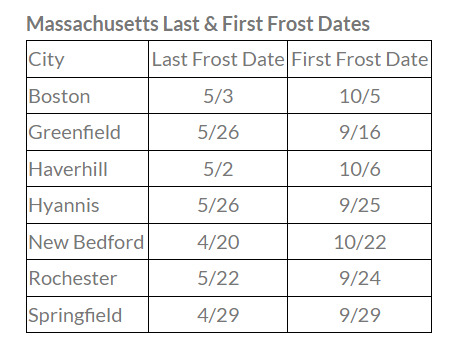
There is a solid 5 month window for planting annual crops, like corn, melons, and gourds like pumpkin. Your perennial crops are limited to fruit trees and possibly grains, depending on the variety and whether or not a perennial variety has been bred.
Cold weather crops include beets, carrots, greens like cabbage, collards, kale, and potatoes. These aren't the types of crops that will survive the winter as much as these are foods that can go in the ground as soon as it is unfrozen enough to be workable. Root vegetables and greens can germinate in soil as cold as 40 degrees Fahrenheit, which provides some leeway with unpredictable frosts and late planting times.
Much of the agricultural landscape of Massachusetts is dependent on the dairy industry, farming cattle, and aquaculture -- fishing and catching shellfish. Those with access to the coasts, fish and shellfish ought to provide protein during lean months.
Why are we talking about this? Well, if we're stepping into the shoes of a subsistence farmer in the fallout universe, we're going to have to take into account climate and ideal planting times for certain crops. It's not wholly important in terms of things like fic writing, unless you happen to be writing about the life and times of wasteland agriculture, in which case, I hope this is helpful! Again, I am pedantic, and this section is to provide a template when considering and discussing other parts of the game and what their specific diet and agricultural landscapes might look like.
Something to keep in mind when thinking about how farms might function in the Mojave, for instance, or if you're doing worldbuilding for a different part of the US.
Crops in the fallout universe
Now that we're familiar with growing zones and why certain crops are planted and when, we're going to apply some speculative worldbuilding to fallout itself. We will be revisiting growing zones when we talk about other climates, but for the moment, we're going to focus on fallout 4.
Now to preface -- I don't think that the food that is given to us in game is wholly representative of the plants or animals that survived the apocalypse. If some managed to mutant and survive, I'm willing to bet others did. I certainly won't deduct any points from anyone who wants to talk about growing cotton, or farming peaches or cherries, and I won't raise any eyebrows if someone includes things like spices into their wasteland cuisine.
In the 210+ years since the bombs fell, I do not think that the majority of the US is a desolate wasteland, but this post is not going to be my beef with the devs about how brown everything is. This beef is about food in particular. However, for sake of ease, I'm mostly just going to focus on the food that is presented to us in game.
There will be some extrapolation and speculation later, but if I do that for everything, then we'll be here all day, and we've all got things to do.
I would also be remiss to mention that agriculture in the US is old. It predates colonialism. The Native Americans cultivated the land long before any European settlers. They practiced a type of crop growing referred to as Three Sisters planting, which utilized corn, pole beans, and squash -- all things that exist in the agricultural landscape of Fallout as we know it.
Corn
I'm not going to say much about corn because there's not a lot to say about it. We all know what corn is. Fallout's corn is visually similar to wild violet, a hybrid corn.

But I am not going to say Fallout's corn is one such variety or another. In the 210 years since the bombs dropped, I imagine corn varietals have been bred and interbred a thousand times, and it is probably it's own unique strain. It's kind of a moot point. Corn is corn. You can do with yellow corn what you can do with wild violet, and whatever special breeds that make up Fallout's corn.
Corn is the third largest plant-based food source in the world. Despite its importance as a major food in many parts of the world, corn is inferior to other cereals in nutritional value. Its protein is of poor quality, and it is deficient in niacin. Diets in which it predominates often result in pellagra (niacin-deficiency disease). Corn is high in dietary fibre and rich in antioxidants.
You can do a shit ton with corn. It's a staple grain. It would not be incongruous with the fallout setting to have settlers making tortillas, cornbread, polenta, grits, tamales, etc. Corn can also be used to make corn whiskey. The husks can be spun into yarn and woven into garments similar to cotton, which I thought was interesting and also solves the problem of where the hell wastelanders are getting their clothes. Corn can be used as livestock feed, especially in the winter when cattle can't graze. While corn is a staple grain of the US, the east coast has minor corn production compared to places like the midwest. Corn is a staple, but it does not consist of the entire diet of your average wastelander.
Carrots
Not going to say much about carrots either. They're carrots. They grow well in colder soil and tend to have a lot of natural sugars. The carrots we're shown in FO4 seem to be a mutated variety different than the "fresh carrot" consumable in FNV, but there's virtually no difference, so I'm not counting it. Make some carrot cake.
Razorgrain
"This species appears to be quite promising. It's a toothy grain that we may be able to grind in order to replace wheat, which is untenable in the Wasteland. We are uncertain how to increase crop yields, which are very unpredictable. Will continue to study."
Razorgrain is our first unique mutated crop in the fallout setting. It most closely resembles a barley or a rye. Both are a fairly hardy species and can grow all across the continental united states; rye can germinate in cold weather temperatures. It wouldn't be outrageous to assume that razorgrain is similar too or a crossbred variation of both rye and barley. I have decided to base the majority of my research assuming it is a barley variant. Barley is also a major crop on the east coast near the Commonwealth, so that would explain why razorgrain is present in FO4 and not in the other games.
Barley requires a mild winter climate and can grow in growing zones 3-8, so it would be viable in Massachusetts. Barley can be milled into flour and it contains gluten; the gluten content of North American wheat and barley tends to be higher to survive the colder climates, so razorgrain would likely be very glutenous. It is also less susceptible to ergot than rye, but barley can still become infected -- and, I am assuming, razorgrain could as well.
Razorgrain fills the nutritional niche of carbohydrates and can be used to make breads, cakes, pastas, etc. It produces darker breads that have an earthier flavor than milled white flour. There has to be some method of actually milling the grain, though, which is an intensive process that can often be dangerous. Grain can also be used to make malted candy, which is our first option for wastelanders with a sweet tooth. Obviously, razorgrain can also be used to make malt or grain alcohol and is probably the source of all the beer you find littered around the wasteland.
Gourds and melons
Gourds and melons are actually a part of the same family, Cucurbita. The category of 'gourd' covers several different kinds of vegetables, including ornamental fruits that shouldn't be eaten. We aren't going to spend a whole lot of time on this one, simply because canon doesn't tell us that much and there's a lot of wiggle room in terms of interpretation.

FO4's model looks the most similar to a pumpkin, but it could be some other squash varietal from the Cucurbita family, which includes watermelon, honey melon, cucumber, squash, zucchini and pumpkin.
Melons is another pretty broad category. Melons and squash are part of the same family, as mentioned above. If we're going visuals again, the model is likely intended to resemble a watermelon. Watermelons grow best in humid and semi-arid environments between 70 and 8- degrees Fahrenheit. It's not impossible for wastelanders to be growing watermelons, but considering the humidity and frequent rainfall in Massachusetts, the melons would be vulnerable to fungal infections.
There isn't a lot of information on what specifically gourds and melons are in the fallout universe, so you could get away with writing in a pretty wide variety. Personally, I lean a little bit towards melons being a muskmelon variety, like cantaloupe or honeydew. Squash fills in some vitamin requirements for the human diet, and can be canned and stored for winter. It tends to be high in vitamin C and magnesium.
The limit to this one seems to be your imagination. Go crazy.
Mutfruit
This wiki claims that the mutfruit (it has a scientific name apparently, malus maata) is a mutated species of apple and crabapple. There are two different wikis about the mutfruit, both distinct. The first is linked above. The second is linked here -- I got most of my information from this second wiki.
There is a handful of "canon" information we can take from this set of wikis.
Priscilla Penske in Vault 81 is attempting to create foods that have increased resistance to radiation. She mentions the mutfruit would do well, but isn't certain how the hybridization would affect the flavor and texture.[5]
This claim is taken directly from the second wiki, but in comparison, it makes no sense. If the mutfruit tree is a product of mutation, then radiation shouldn't really affect it at all. It's survived and propagated to this point, hasn't it? I am disregarding this claim on the basis of being stupid.
Farmers in at Warwick homestead will comment on the fruit's characteristics, such as tasting sweet and being versatile in recipes.[1][2]
The vault dwellers of Vault 81 trade for mutfruit with the outside world, and use it to make special occasion desserts such as pie.[6][7]
If the mutfruit is an apple variant, then it likely has a high sugar content, and it would have to be harvested in the peak of summer or in early fall.
There are fresh apples the be found across the wasteland, implying the existence of apple trees that have been unaffected by the bombs. Personally, I was assuming that the mutfruit was some kind of blackberry, given its appearance as a clustered fruit, or maybe even a type of plum. Regardless, the mutfruit is a fruit, which means that it would preserve well by being jarred or canned, has a high sugar content, and could likely be reduced to form sugar syrups. Like any fruit, it could be used to make alcohol.
Tatos
I want to stop myself from editorializing too much, but goddamn tatos. The crop that makes the least goddamn sense in the fallout universe. The bane of my existence. Let's get into it.
First off, we're given some pretty damning canon facts about tatos:
Tatos are a mutated hybrid of the cross-pollination of the tomato and potato plants.[1] The new consumable looks like a tomato on the outside, but the inside is brown.[2] Commonly cultivated in the Commonwealth, Appalachia and on the Island, its fruit is easy to grow and can keep one from starving, but their taste is described as "disgusting"[2][3][Non-game 1] and resembling "ketchup-flavored cardboard."[1]
According to some old botany texts we found, this appears to be combination of a now extinct plant called a "potato" and another extinct plant called a "tomato." The outside looks like a tomato, but the inside is brown. Tastes as absolutely disgusting as it looks, but will keep you from starving.
Note: This text was written from the perspective of someone who is unaware that both the tomato and the potato are being cultivated elsewhere. The writer also does not mention any sort of DNA test. However, the potato is also found in the Capital Wasteland, and the writer is a scribe in the Brotherhood of Steel, which originated from that area.
Both potatoes and tomatoes are from the nightshade family. They have the same nutrient requirements, and would compete for resources if planted separately but in the same soil. There is a method for planting them together where you splice a tomato stalk onto a potato root, but this is not the same as cross pollination and will not result in what fallout presents as a tato. What will happen is that the roots will grow potatoes and the fruit of the tomato will branch off the stems.
The potato itself is a stem tuber -- high in starch and calorically dense. A stem tuber is an offshoot of the parent plant that will grow beneath the soil as a type of asexual budding reproduction. We all know what a potato is. The tomato is a berry. It's the ovary of a flowering plant -- again, we all know what a tomato is.
I am going to give Fallout a little bit of grace and not comment on how mind bendingly stupid their description of a tato is. The outer skin is a tomato, but the inside is brown and starchy like the potato? I am not going to comment on how it makes little to no biological sense. The starchy tuber is starchy because it's an energy and nutrient storage device. The tomato is the enlarged ovary of a fruit. Why did those things, which are separately very good, combine into one very terrible thing? I don't know. It doesn't make sense. I don't really want to think about it. But these are the facts as they are given to us in game and I suppose I have to live with that. Obligatory "goddamn you todd howard. a pox on your house."
The tato is probably extremely calorically dense. It's specifically mentioned as being easy to grow and it is a better alternative to starving. It's probably grown as a staple crop throughout the planting season. I'm not entirely sure if the tato can produce glycoalkaloids like the potato does (that is, the green sections of the potato that can become poisonous when exposed to light) but if they can, and if stored improperly, it would negatively impact the health of whoever ate them.
I suppose since the taste is so offensive, tatos are better served as a carrier of some other type of food. Fried, mashed, baked -- the purpose of the tato is simply to get calories into your body. Starch can also be turned into alcohol, which I am going to need a lot of after reading the canonical facts of this stupid fucking plant.
Fallout: The Roleplaying Game Rulebook p.158: "A mutated hybrid of the pre-War tomato and potato plants, with the stem and reddish skin of the former and the brownish flesh of the latter. Tatos provide decent nutrition, but taste disgusting. However, they’re relatively easy to grow and thus are a staple of wasteland agriculture and is an ingredient in a variety of recipes."
fucker
"non farmable" crops
You can't cultivate these plants, but again - we're taking what's given to us and interpreting it extremely literally. There is no reason that these crops could not be domesticated and farmed.
Siltbean
Siltbean is likely a type of bushbean, rather than a pole bean. It's squat and low to the ground. Bush beans require little care or attention and you can pick them when you're ready to harvest them. Historically in North America, beans and corn were grown side by side (though those beans were pole beans using the stalks as support). Bush beans require successive plantings since harvests are early.
There's no good allegory for what type of bean this might be. The potato bean (Apios americana) is native to North America and also produces edible tubers, but there's no reason this couldn't be just some other type of bean. No beans that I could find had red/orange pods.

Beans are a good source of both proteins and carbohydrates, and another crop that can store well for the winter.
Tarberry
Tarberry is a little iffy, considering it is farmed by the ghouls at The Slog, but they're the only farm shown capable (or willing?) to farm the berries. Originally, I had assumed that tarberries were a type of mutated cranberry, and I thought the wiki was supporting me in that claim by saying this:
Tarberries are small, dusty orange berries of the tarberry plant. It is a water-grown crop similar to cranberries.
But cranberries themselves are also canon in the world of Fallout. So who knows! There's no canon information presented on the tarberry's characteristics, so it can be treated the same as any other fruit or berry.
Fungus variants
Glowing fungus: Glowing fungus is one of the few real world equivalents we have. It is a Japanese mushroom called Enoki. It is also farmable as shown in FNV at Hell's Motel.
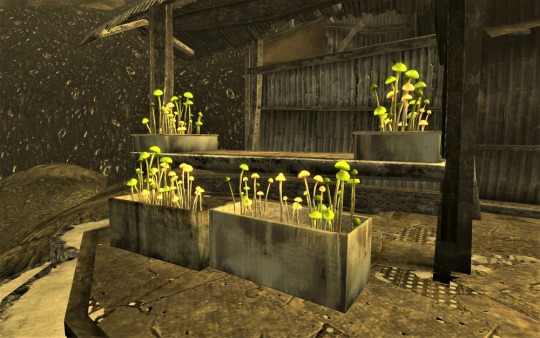
Brain fungus: This is harvestable, but there aren't any "crops" shown as we would consider them. Considering it's benefits as a mentat replacement, then it's likely that there could be a dedicated space for growing it.
Food and Plants mentioned in the text
Potato
Thank god almighty, potatoes are canon in the universe of Fallout. Fresh potatoes are found as consumables in FO3 and FNV but potatoes are also mentioned in the text of FO4:
Mentioned in dialogue -- {Angry} Shut up Jake. If I hear anything out of either of you, you'll both be peeling potatoes for the next year.
I'm taking this as word of god. Potatoes are canon and I don't care what anyone says.
Tomato
Tomatoes are mentioned in the text, but are never actually seen in game. The only hint that this plant survived extinction is this excerpt from the wiki.
Note: As fresh tomatoes and potatoes are seen in the Mojave Wasteland as of 2281, with the potato seen in the Capital Wasteland as of 2277, the claim of either's extinction by 2287 in the Commonwealth Plant Database could be taken to mean local extinction in east coast regions, as opposed to global extinction. This entry may also just be in error.
There's potential for leeway here, but take it as you will!
Fresh apple
We discussed this back up in the mutfruit section of the essay, but the existence of fresh apples implies the existence of non mutated apple trees. They're found in both FO3 and FNV as a consumable item, so the apple tress have either proliferated across the continental united states, or multiple varieties survived the bombs.
Fresh pear
See above. Pears are also naturally high in pectin, which makes them useful for making jams and preserves.
Pinto beans
Pinto beans are a consumable in FNV and is another W in the bean category of the agricultural landscape.
Jalepeno
Look, I'm picking out this one specifically because I need to believe that other spices and peppers exist in the world. Where would we be without her? Nowhere good.
Raw sap
I am going to say that sap collecting is probably where most of the sugars and sweeteners in the wasteland come from. It's relatively easy to tap trees and collect sap, and it only takes a few hours to reduce the sap down into useable syrup.
Wild Blackberry, Lime, Cranberries, as well as Watermelon as being distinct from simply 'melon' are all mentioned in the text. The list of fruits mentioned or found in the games can be found here.
Animal husbandry
Fallout doesn't give us a lot of canonical information on the animal side of farming. The biggest real world agricultural export of Massachusetts is dairy and cattle farming. Chickens are canon in the worldbuilding of fallout as of Far Harbor, but canon feels both restrictive and extremely loose with regards to what animals can be cared for and how.
We aren't going to spend a whole lot of time on this one, only because the information is pretty limited.
Brahmin
There are plenty of brahmin found throughout the landscape of the wasteland. We most commonly see them as either livestock or beasts of burden. Things like milk, cheese, and other dairy products would be common if a farm has access to dairy cows. The investment to raise cows would be enormous for a subsistence farmer. Dairy cows would likely be kept for a number of years, where steers would be raised 12 to 24 months before being slaughtered; they'd likely be grass fed in the summer and corn or grain fed in the winter. Leather and beef would be products, of course, and things like soap and candles can be made from the beef tallow.
Chickens
Chickens are largely easy to keep and care for, producing eggs and necessary proteins. Chickens can provide niacin, filling in the nutritional gap that would be left by a heavy corn based diet. The investment for keeping chickens is lower than raising brahmin, but so is the payoff.
Bighorners
Bighorners are mutated bighorn sheep native to the American Southwest.[1] Humans have since domesticated them for their horns, meat, milk, and hides,[2][3]
Granted, bighorners are only seen in FNV, but I don't think there's any reason they couldn't have migrated east. In the text, it says they're kept for meat and milk, but there's no reason that they shouldn't provide a fleece as well. In the colder climate of Massachusetts, they would find value in wool, which can keep its warmth even when wet. They may be sparse across the commonwealth, but that would make wool and fleece all that much more valuable.
Fish
Yeah, I know. Technically we can't fish in Fallout (and depending on the game you play, you might not even know what a fish is). But aquaculture is huge in Boston, and with access to the coasts, it's completely fair to say that fish, shellfish, and hydroponics is a completely viable source of food in the wasteland. We see dead fish washed up on shore all the time, along with whatever the hell those shark things are. There should be fisheries and fishing towns all along the coasts.
New Vegas and Fallout 3
Consulting our growing zone chart, we can see that much of the southwest sits between 7b to 8b. The winters in the southwest are fairly mild, and while you can get seeds in the ground sooner, the majority of the battle is going to be finding a reliable water source.
The farming we see in New Vegas has one distinct notable inclusion: the NCR sharecropper farm.
The sharecroppers are growing a number of crops, including maize, tobacco, pinto beans, and honey mesquite. Corn can handle hot, arid weather, it's just not commercially grown out west. Barley can also handle hot, arid climates, and razorgrain would be suitable for the western front -- maybe we can assume it's made it's way that far west and is being cultivated alongside corn.
Most of the plants we see in FNV aren't the type we would see typically domesticated for agricultural use, but that doesn't mean people haven't adapted to their surroundings. It makes a lot of sense for locals to have domesticated local plants like prickly pear and banana yucca. There are a number of fresh produce items to be found as consumables, alongside local fruits the local fruits.
Heat-loving plants are best suited for summer production in desert climates. The plant families that fit into the heat-loving category are nightshade or Solanaceae (tomatoes, peppers, eggplant) and squash or Cucurbitaceae (cucumbers, melons, summer and winter squash). Corn and beans also perform best in hot climates.
Most plants CAN handle the heat and climate of the southwest, the issue is just finding a reliable source of water. Somewhere close to Lake Mead or the banks of the Virgin River would be prime real estate for farming, since irrigation could be accomplished without the use of pumps, like the sharecroppers use.
If we look back at the history of agriculture, it's developed along established waterways in almost every ancient civilization because that's what's easiest. There should be thriving communities surrounding the lakes and rivers in the southwest.
Comparatively, DC was formerly a swamp. It's hot and humid in the summer, though the winters are fairly mild. It wouldn't be a stretch to say that farming practices in the Commonwealth don't differ all that much from farming in the Capital Wasteland -- you could even posit that food from the Capital is of better quality ever since the successful activation of Project Purity. Fresh and unirradiated food was growing there before, so it's entirely likely that even more is growing now. YMMV!
Other consumables
We would be here all damn day if I did research onto every single consumable item available across all three games, so this mostly just because I'm covering my bases.
I am going to say that sap collecting is probably where most of the sugars and sweeteners in the wasteland come from. It's relatively easy to tap trees and collect sap, and it only takes a few hours to reduce the sap down into useable syrup.
Look, I'm picking out this one specifically because I need to believe that other spices and peppers exist in the world. Where would we be without her? Nowhere good.
Pre War food
Most shelf-stable foods are safe indefinitely. In fact, canned goods will last for years, as long as the can itself is in good condition (no rust, dents, or swelling). Packaged foods (cereal, pasta, cookies) will be safe past the ‘best by’ date, although they may eventually become stale or develop an off flavor.
The risk with improperly canned good, or damaged canned goods, is botulism. Botulism will straight up kill you. You don't even have to consume that much of it; just a little bit will leave you dead in days. As desperate as I might be for a meal, I'm not going to risk dying because that can of two hundred year old peaches looks really tasty.
If properly sealed and in a dry, ideal environment, I... guess things like cereal and instant food could be okay? But again, with access to fresh grain, sugars, and yes, even potatoes and pasta, why would you want to risk eating InstaMash that's been around since before your great grandmother.
Pre War drinks
Sigh. Okay.
Unless stored extremely, extremely well, most bottled drinks aren't going to last much longer than 9 months. A year, if you're lucky. Exposure to sunlight and improper storage will break down the contents -- the best bottles are brown, then green. Clear glass is the worst because it does nothing to protect the liquid inside.
All the Nuka Cola you find throughout the world is flat, nasty, and will probably make you sick. I don't think that really needs to be pointed out, but there we go. I suppose the soda could probably be reduced to form sugar syrups, but with access to sap syrup and grain malt, I'm not sure why you would be desperate enough to do that.
So what does food look like in Fallout?
If there's one thing I know about humans, it's that humans like to eat. Food is culture, as much as culture and community is built around food. Good food and access to it is paramount to human happiness. All this to say is that food in fallout is whatever you want it to look like.
I can extrapolate and theorize all day long based on what Fallout tells us definitively, but I'm not going to tell you what the culinary landscape in the wasteland looks like. The only point that I will stress is that humans are really, really good at making things appetizing.
The fandom is already so creative when it comes to developing their idea of what food means in the wasteland. It's what's directly inspired me to write up this stupid, long ass post about farming and agriculture.
Obviously this is not a comprehensive list of all the base ingredients you can find in Fallout. I picked the ones I did because of the potential for consistent farming. Wastelanders have had two centuries to develop agricultural practices based around subsistence farming. I am not a subsistence farmer, and I have no idea how wasteland cottagecore would work at the heart of it. Running a farm is extremely labor intensive, and so much of your investment has to be immediately recouped in the form of eating what you harvest.
What a farm is likely to look like will start in the early spring when the ground begins to thaw, and a farmer can plant his cold resistant crops, like green vegetables and razorgrain. Potatos, carrots, and tatos will also weather the spring chill. When it starts to warm up, the more delicate plants like corn, beans, and squash or melons will get planted and tended to.
If your family is lucky enough to have a greenhouse, you can keep crops growing all through the winter and have a surplus for trade and barter, or just to preserve and refill the pantries.
A lot of the investment will have to be immediately recouped. Eggs from the chickens can't be preserved, obviously, but there will be meat from hunted animals, milk from the brahmin, probably an early harvest from the beans and tatos, and whatever else is in the pantry from the previous harvest.
Some of it will be canned or preserved in the forms of jams or jellies (just remember what I said about botulism). Meat from animals that get hunted can be smoked or otherwise preserved. Grain can be milled into flour or eaten whole and unshelled. Even the corn silk can be woven into clothes for the summer.
There really is no limit to what can be done in the end. While a lot of this information was taken from what we're given in the text, there's no rule that says you have to follow it word for word. If you believe something exists out there, then write it! We're all just making shit up as we go along anyway. If you need permission, then here it is. You can do whatever you want. Make up recipes! Go insane. Follow whatever your little foodie heart desires.

#fallout#kal talks#fallout 4#fallout new vegas#fnv#fallout 3#fallout meta#fallout food#fallout headcanons#behold. the agricultural masterpost of my farming headcanons#here she is
741 notes
·
View notes
Text
I am no longer in plant hardiness zone 7b I am now in plant hardiness zone 8a
15 notes
·
View notes
Note
I want to plant things, but from my experience up here in Laramie, trying to plant anything before Mother’s Day is the easiest way to ensure that the forecast changes to snow.
So remember how I was talking about how I can fudge my USDA Zone because I live in the greater denver Heat bubble? Yeah, yours fudges the other way because of all the FUCKING WIND y'all get up there. So while my technically-7B ass could theoretically put things in the ground on 4/20 with only mild amounts of hubris, you're in 4B in a good year and I'd be stunned if anything survived being put in before June.
Planting in the mountain Time Zone is basically a balance of Hubris: getting things exposed to enough sunlight that they actually develop, not too much so they don't burn to a crisp, enough water they don't dessicate, not so much as to get a visit from your municipal water board, early enough that they have time to mature before fall, and not so early as to tempt a June Blizzard. You can't commit too much Hubris, but you need to cmmit at least some or you're not going to get crops at all.
235 notes
·
View notes
Note
I just scrolled through your posts: wow! So many beautiful fruits and veggies !
How much land do you have and in which area are you located?
Not that I want to raid your orchard. 😁 I was just wondering what conditions make all these things grow so well. Yes, of course your hard work and your love for gardening but that would not be enough in Norway, just to make an example.
I am really curious.
Hello! Thank you so much, you're too kind! :)
I'm located in Romania, zone 7b. The climate here has its challenges, more so lately, but it does allow me to grow most of the things I want.
I have an almost 4 acres orchard with a 25x30 m veggie garden in it, where I grow most of my plants. Other than that there's a tomato garden at my parents' house (I couldn't tell you how big, but there are some pictures of it on the blog) and a small berry garden along the side of the house (I recently posted a sketch of it).
23 notes
·
View notes
Note
List 5 things that make you happy, then put this in the askbox for the last 10 people who liked or reblogged something from you! get to know your mutuals and followers :P
This is very fun and cute thank you…
1. Gardening, it’s the time of year when all my fall and winter bulbs are coming up and I get to start planting seeds for summer (zone 7B so I get to start pretty early) yayyyy
2. Cats, both my own and just the animal in general. #1 animal or creature of all time
3. A blanket “my loved ones” because I have many but special shouts to my husband who’s sitting on my feet rn
4. All my other hobbies like writing my little fanfictions, cooking/baking, etc! I like being busy as long as it’s stuff I enjoy
5. Going to goodwill and finding stuff for my house, I’m slowly curating a museum of all my junk and treasures
2 notes
·
View notes
Text




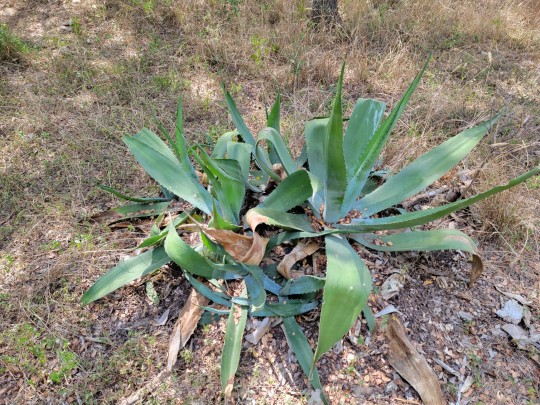

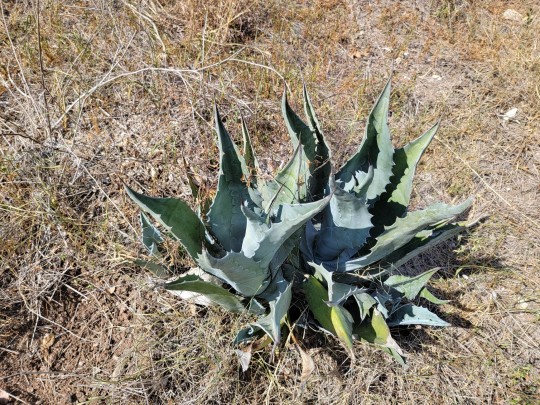
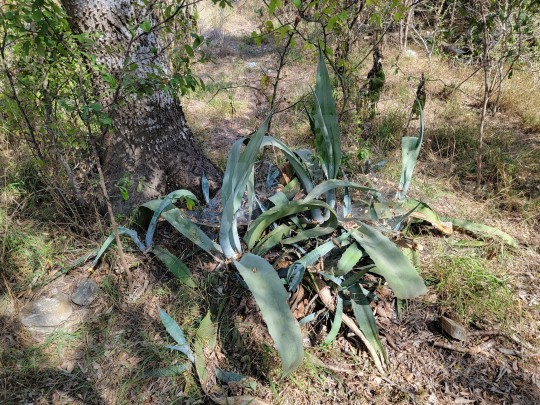

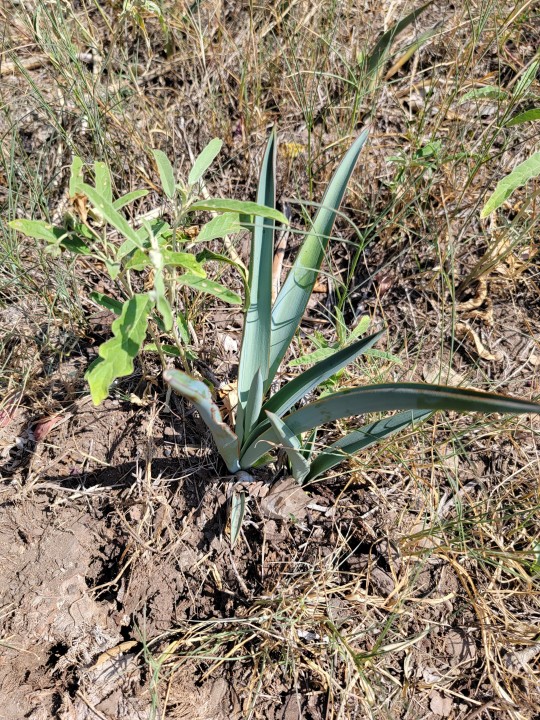
With regard to Onion Creek more generally, this year's drought and extreme heat appears to have been a net positive for extant agave colonies (and yuccas, like the last plant here). The weather suppressed growth of grasses and forbs, which meant the city did less mowing, which allowed these xeric plants to rebound from small pups or underground stolons.
This does help answer some questions I had regarding the pattern of plants that have survived. Very popular landscaping choices with low water needs like Hesperaloe parviflora and Cycas revoluta are completely absent here, and have been since I first started visiting in 2017. It's obvious now that a lot of those mid-sized plants were either removed or bulldozed, and did not have the ability to regenerate. The big winners among ornamental non-natives in the years since buyout demolition began* have been xeric plants with stolons, bulbs, and rhizomes that sit at or below ground level, and cold tolerance to at least USDA zone 7b.
I don't know what the long term fate of all this is. Though it's a park now, the city continues to build paths and add amenities like picnic areas and gazebos. Plants that are not already large enough to function as shrubs may continue to get chopped down until the colonies die out. Or not. There's years to go.
*I did say in previous posts that buyouts began following the 2013 Halloween flood, but that's incorrect. They expanded after that event, but buyout of the most flood-vunerable homes actually began after Hurricane Rita in 2006, informed by a U.S. Army Corps of Engineers study conducted after flooding in 1998.
32 notes
·
View notes
Text
Guys reblog this with plants fruits and vegetables you think I should look into for my garden, I live in the south in zone 7b/8a incase that changes anything, just please share some cool plants with me!
5 notes
·
View notes
Text
It is the twelfth of April, 2023, and I live in Zone 7B, which means that today marks the 50% chance of there being no frost until Autumn. Fifty percent chance of frost between now and two weeks from now.
The weather prediction websites all say we're going to have highs in the seventies and eighties, lows in the fifties at worst, for the next ten days. Ten days from now, we'll be down to 20% chance of frost between now and October.
Every year I get the same imp whispering in my ear. Put those plants out now, she says. There's not going to be any more cold weather, and it's exhausting having to water them all with gallon jugs every day when you could be watering them with the hose twice a week.
This year is worse. This year I have something like two thousand plants that need to go into the ground, all told--pollinator plants, vegetables, pretty flowers for me. The sooner I can get on it, the better.
I know it's a bad idea.
Still...
3 notes
·
View notes
Text
Learning with Lysander Part 1
Average Annual Extreme Minimum Temperatures in Fahrenheit (°F) and in Celsius (°C)

This chart is not fully up to date more than likely but I needed to give you a picture of the world's growing zones.
Zone °F °C
1a. -60° - -55° -51.1° - -48.3°
1b. -55° - -50° -48.3° - -45.6°
2a. -50° - -45° -45.6° - -42.8°
2b. -45° - -40° -42.8° - -40°
3a. -40° - -35° -40° - -37.2°
3b. -35° - -30° -37.2° - -34.4°
4a. -30° - -25° -34.4° - -31.7°
4b. -25° - -20° -31.7° - - 28.9°
5a. -20° - -15° -28.9° - -26.1°
5b. -15° - -10° -26.1° - -23.3°
6a. -10° - -5° -23.3° - -20.6°
6b. -5° - -0° -20.6° - -17.8°
7a. 0° - 5° -17.8° - -15°
7b. 5° - 10° -15° - -12.2°
8a. 10° - 15° -12.2° - -9.4°
8b. 15° - 20° -9.4° - -6.7°
9a. 20° - 25° -6.7° - -3.9°
9b. 25° - 30° -3.9° - -1.1°
10a. 30° - 35° -1.1° - 1.7°
10b. 35° - 40° 1.7° - 4.4°
11a. 40° - 45° 4.4° - 7.2°
11b. 45° - 50° 7.2° - 10°
12a. 50° - 55° 10° - 12.8°
12b. 55° - 60° 12.8° - 15.6°
13a. 60° - 65° 15.6° - 18.3°
13b. 65° - 70° 18.3° - 21.1°
These are referred as "Hardiness Zones" and not usually split into a/b. Ex. Zone 7. Certain plants can only handle cooler environments while others can only handle warmer environments. Depending on the plant, there is a chance it can handle several zones with minor differences here and there on growth rate, size and yield. Very few species can thrive anywhere. You can grow anything and everything if you have the means to do so, which will be the next lesson- Greenhouses.
3 notes
·
View notes
Text
A Bounty of Exotic Fruits: Thriving in Zone 7b

Zone 7b boasts a rich tapestry of fruiting plants, encompassing both familiar favorites and lesser-known exotic varieties. Whether you're drawn to the sweet allure of figs or the tangy zest of passion fruit, there's a wealth of options to explore in this diverse climate. In this guide, we'll delve into an eclectic selection of fruiting plants that thrive in Zone 7b, offering a tantalizing array of flavors and textures to delight the palate and enhance your garden landscape.
•Exploring the Bounty of Zone 7b:
Fig: A Timeless Favorite Figs, with their luscious sweetness and adaptability to various soil types, are a cherished addition to any Zone 7b garden. Their ease of cultivation and delectable fruits make them a must-have for fruit enthusiasts of all levels.
Guava: Tropical Splendor in Temperate Climates Certain guava varieties, like the pineapple guava, defy expectations by thriving in Zone 7b with proper winter protection. These exotic fruits bring a taste of the tropics to your garden, infusing it with their aromatic flavors and vibrant colors.
Passion Fruit: Aromatic Treasures Await Passion fruit vines, though requiring frost protection in winter, reward gardeners in Zone 7b with their aromatic and flavorful fruits. Their unique taste and versatile uses in culinary creations make them a prized addition to any fruit garden.
Jaboticaba: A Brazilian Gem Native to Brazil, the jaboticaba tree offers a truly distinctive fruiting experience, with grape-like fruits growing directly on its trunk. With proper winter care, this lesser-known gem can thrive in Zone 7b, captivating observers with its unusual fruiting habit.
Sapote: Tropical Delights in Unlikely Places Sapote trees, including black and white varieties, transport Zone 7b gardeners to tropical realms with their delicious and unique-flavored fruits. With frost protection, these exotic treasures can flourish, adding a touch of tropical flair to your garden oasis.
•Unlocking Possibilities with Veliyath Gardens:
If you're inspired to embark on a journey of exotic fruit cultivation, look no further than Veliyath Gardens. As the premier seller of rare and exotic fruit plants in India, we offer an extensive selection of over 1000 rare fruit plants sourced from around the globe. With meticulous care and expertise, we nurture these rare specimens on our farm, ensuring they are ready to thrive in your Zone 7b garden. Visit our website today to explore our diverse offerings and elevate your gardening experience with the allure of exotic fruits.
•Conclusion:
Zone 7b beckons adventurous gardeners to embrace the diversity of fruiting plants available, from familiar favorites to exotic treasures. With the right care and attention, these plants offer a bounty of flavors and textures that elevate the garden experience. Whether you're drawn to the familiar comfort of figs or the exotic allure of jaboticaba, there's a world of possibilities waiting to be explored in Zone 7b.
#exoticfruit#tropical plants#fruit plants#fruits#exotic fruit plants#ExoticFruitPlantGarden#TropicalPlantParadise#RareFruitPlantLove#ExoticEdiblesFacebook#FruitfulPlantJourney#TropicalPlantInspiration#ExoticGardenDelights#FruitfulPlantDiscoveries#TropicalPlantMagic#DiscoveringExoticFlavors#FacebookFruitSafari#RareFruitPlantShowcase#TropicalPlantEnthusiasm#ExoticPlantAdventures#FruitfulPlantExploration#ExploringExoticFruits#TropicalFruitPlantJoy#ExoticPlantGrowth#FruitfulPlantBeauty#TropicalPlantCommunity#ExoticFruitPlantWonder#ExoticFruitPlantAdventures#TropicalPlantExploration#FruitfulJungleJourney#treanding
1 note
·
View note
Text
Fun fact: Climate has changed so much in the last 30 years that the plant hardiness zone of where I grew up went from a 6b to a 7b. Check it out and love how climate change has impacted plants around you.
0 notes
Text
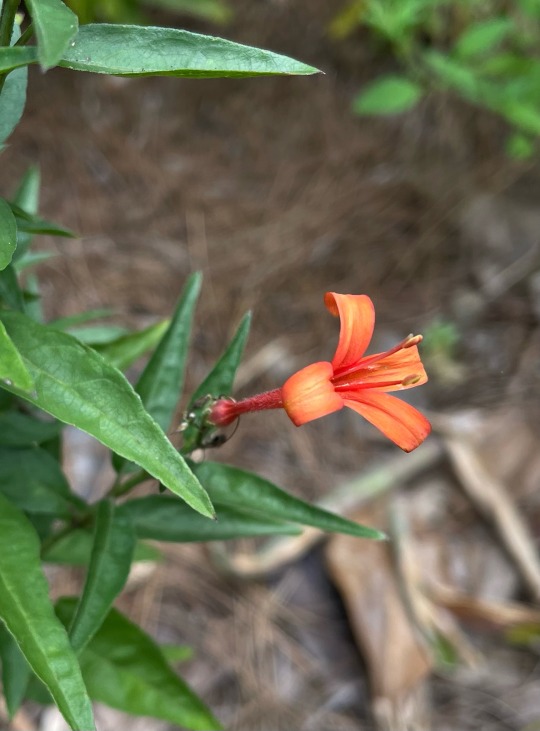
Typical colored form of Anisacanthus wrightii, a hummingbird-pollinated member of the acanthus family from southern TX. I’m really pleased with this species so far; it’s handled a phenomenally shitty bed at work (fill dirt, awful root comp, sloping, parking lot esque radiative heat, years of what I call “bad soil hygiene”*) quite well and of all plants I had at nursery it was least impacted by 3 days of 99 F. It is listed as hardy to zone 7b but experiences by other gardeners indicate it needs heat to flower with some upper Midwesterners I know only getting results by keeping it in pots on driveways. It can be ungainly in some contexts but I suspect a lot of that is too many nutrients, something I do not encounter growing it in FL lol
It’s also in Acanthaceae and every subshrub (branch-y perennial as opposed to basal rosette eg a dandelion) species I’ve worked with roots like a dream so you can quickly make a clone army. If there’s a native subshrub acanth in your area I recommend trying it out for this reason
There are other forms of this species in cultivation. Two offered by my favorite online nursery (Almost Eden) are the following:

‘Pumpkin Pie’
(I plan on picking up this one for myself bc I’m a sucker for mango-colored flowers and I need a trooper to go by the mailbox)

‘San Antonio Red’
*inspired by sleep hygiene as a term, I use good soil hygiene to describe maintenance regimes that preserve or improve soils over time. Bad soil hygiene denudes them and can favor bacteria rather than fungus-dominant profiles (common difference between newly added soil vs mature ones) which lowers drought tolerance. Common example is taking too much leaf litter away
0 notes
Text
Choosing a 7B Landscape Tree for Your Marietta Yard

Need help selecting the best tree for your Hardiness zone 7b yard? Understanding different tree species’ characteristics and growing habits will help you plant a tree that fits perfectly in your yard.
toddsmariettatreeservices.com gathered the following tree species and growing information for zone 7b landscape trees.
What is a Landscaping Tree?
Landscaping trees are planted to create diversity and serve one of many purposes on your property. These trees come in all shapes and sizes and can be among the most significant assets to your yard by providing shade, privacy screens, wind protection, wildlife refuge, visual interest (curb appeal), and other uses.
What are the Benefits of Landscape Trees?
Landscape trees reduce air pollution and noise pollution. They also filter water and absorb rainfall, lessening the impact of flood and stormwater and preventing soil erosion. Trees also attract a variety of birds and natural wildlife, providing food and shelter.
Note: A large, healthy tree can absorb approximately 40,000 gallons of groundwater annually, returning it to the atmosphere through evapotranspiration.
What are the Best Trees for Your Front Yard?
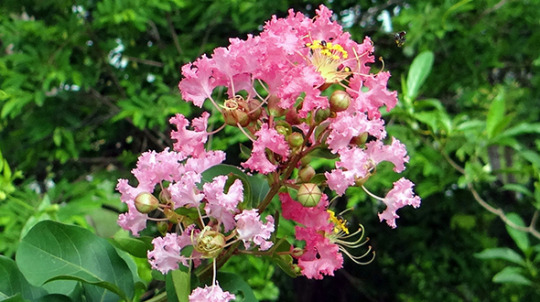
Flowers add pops of color, and mulch creates a clean, well-manicured look. With trees, you can balance height and width in your landscape. Trees are among the best ways to draw the eye, add height, and create a relaxing balance. Curb appeal helps sell a home (trees significantly contribute to curb appeal), and here are a few of the best front yard trees:
Crepe Myrtle (Lagerstroemia) reaches 15 feet
Blue Spruce (Picea pungens) reaches 75 feet
Cherry (Prunus avium) reaches 25 to 30 feet
River Birch (Betula nigra) reaches 60 to 70 feet
Magnolia (Magnolia) reaches 70 to 80 feet
Tip: Avoid catastrophic structural damages by planting your trees at a safe distance from structures on your landscape.
What are the Most Low-Maintenance Landscape Trees?

Once you have determined your tree’s purpose in your landscape (flowers, evergreen shade, privacy, etc.), you should consider the tree’s maintenance. Some landscape plants drop fruit and nuts, while others grow with invasive or surface roots, disturbing your yard, driveway, and foundation. Consider the following low-maintenance landscape trees:
Japanese Maple (Acer palmatum) reaches 25 to 35 feet with delicate branches and vibrant foliage
Jacaranda (Jacaranda) reaches 25 to 40 feet with striking blue and lavender flowers
Redbud (Cercis) reaches 10 to 20 feet with deep red, bright yellow, or two-colored foliage
Frangipani (Plumeria) reaches 20 to 25 feet with non-invasive roots and an abundance of beautiful flowers
Cherry Plum (Prunus cerasifera) reaches 25 feet with deep purple foliage and pink/white flowers
Tip: All tree species require seasonal pruning and thorough inspection after severe weather.
What are the Best Trees to Plant Near a House?

Smaller trees with shallow or non-invasive roots pose little or no risk to your home. Consider the following low-risk tree species:
Weeping Willow (Salix babylonica) reaches 30 to 40 feet
Paper Birch (Betula papyrifera) reaches 50 to 70 feet
Silver Maple (Acer saccharinum) reaches 50 to 80 feet
Sweetgum (Liquidambar) reaches 60 to 75 feet
Crabapple (Malus) reaches 15 to 20 feet
Tip: Towering tree species like southern pines and eucalyptus should be given extra space and not planted within 40 to 50 feet of landscape structures.
Why do Landscape Designers Prefer Male Trees?
Trees with male reproductive organs are preferred in landscapes because they don’t drop messy seed pods or fruit. However, they do produce and release pollen.
Note: When female trees, which capture pollen, are absent from significant landscape areas, the entire area can be blanketed by mass amounts of pollen.
What is the Best Pine Tree to Plant in Zone 7b?
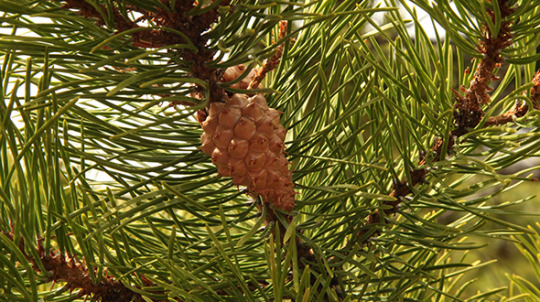
Pine trees are often used in landscapes as privacy screens and specimen trees because they are fast-growing, shapely, and evergreen. Consider the following pine tree species for your landscape needs:
Loblolly Pine (Pinus taeda) reaches 60 to 90 feet
Austrian or Black Pine (Pinus nigra) reaches 50 to 60 feet and requires ample space to flourish
Lodgepole Pine (Pinus contorta) reaches 70 to 80 feet
Red Pine (Pinus resinosa) reaches 50 to 80 feet
Eastern White Pine (Pinus strobus) reaches 50 to 80 feet
Tip: Avoid planting pines near driveways and carports (overhanging branches can leave your vehicle or structure riddled with sap droppings). Pine trees produce and drip sap. The sap flow is heaviest in spring and early summer. During winter, sap slows down and picks up again as spring approaches.
Marietta Georgia Zone 7b Landscape Trees
In this article, you discovered species information and growing characteristics for several popular zone 7b landscape trees.
Knowing which trees to plant around your home and landscape will help you create a beautiful yard with purpose and elevated curb appeal.
Planting the wrong tree species in the wrong location can result in catastrophic root damage to your landscape, driveway, pathway, foundation, and home if it falls on your roof.
Sources:
usgs.gov/special-topics/water-science-school/science/evapotranspiration-and-water-cycle#overview
extension.tennessee.edu/publications/Documents/SP517.pdf
extension.uga.edu/publications/detail.html?number=b625#title11
uaex.uada.edu/publications/pdf/FSA-6126.pdf
Todd’s Marietta Tree Services
Marietta, GA
(678) 505-0266
For the original version of this article visit: https://www.toddsmariettatreeservices.com/choosing-a-7b-landscape-tree-for-your-marietta-yard/
#Landscape Tree#USDA Hardiness Zone 7B#Zone 7B#Marietta Landscape#Tree Service Marietta Ga#Emergency Tree Removal Marietta Ga
1 note
·
View note
Note
Um. My mom lives in Colorado too. She recently purchased a persimmon tree, because it was rated 7 - 10 and "higher number is better right?" (-‸ლ) Already covered the no not better CO is zone 5. But, uh, any chance we're keeping this thing alive long enough to get fruit for any number of years if we're going to try moving it in and out of the house?
OK so for those of you just tuning in, when a Plant is rated a Number, it's referring to is USDA Agricultural Zone. In general, the higher numbers refer to hotter areas, because the zones are based on the average lowest temperature. a Persimmon rated 7-10 will do best in an area where it doesn't get below 0-5 Degrees in winter.
so the answer is... Maybe! it depends on where you live in CO:
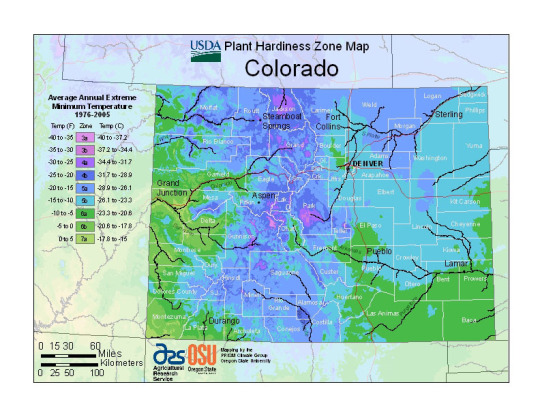
Now, this is map is a bit dated, CO has gotten hotter and more extreme in the last 15 years. According to this, my house is in zone 6B, but in practice it's never gotten below 5 so it's actually in zone 7B.
So, depending where you are in the state (Esp Denver Metro because the city keeps the air warm), and if you plant it in the hottest section of your yard, and cover it if it's going to go below 5 degrees in winter, it actually stands a decent chance of making it!
282 notes
·
View notes